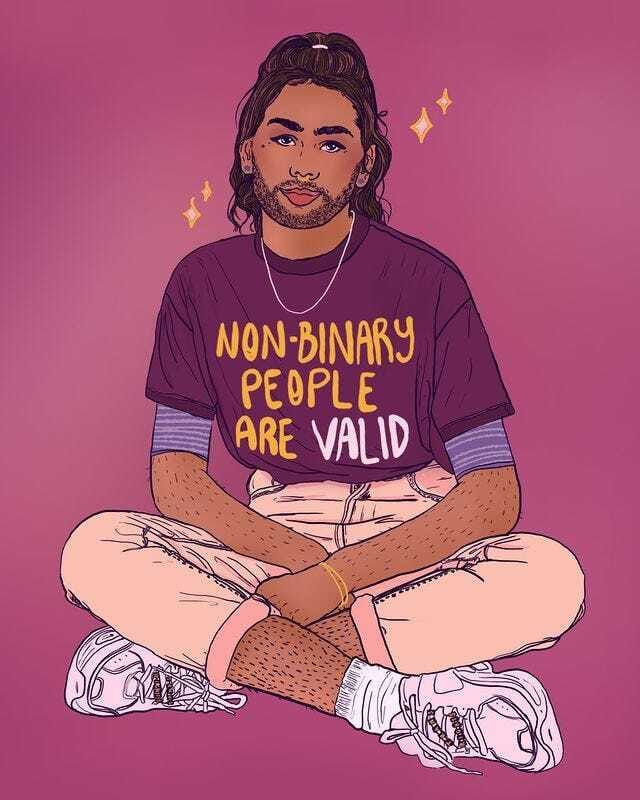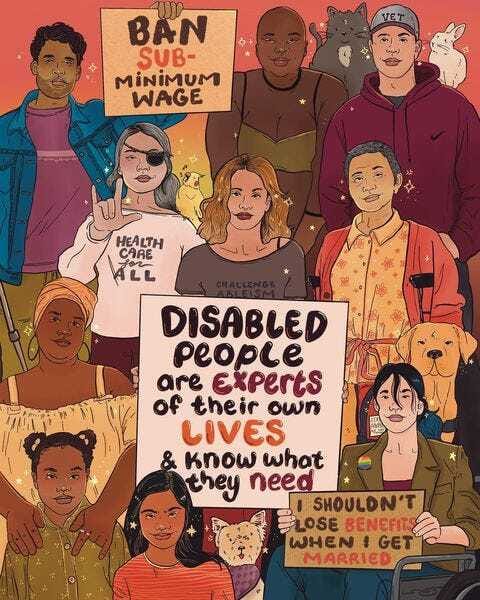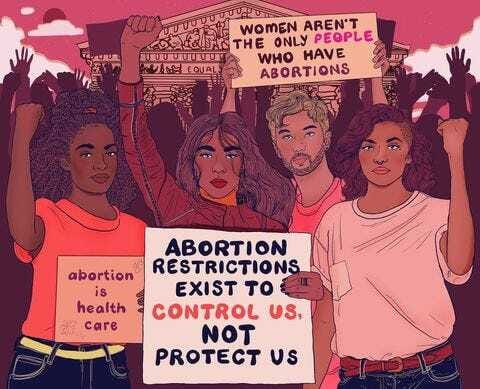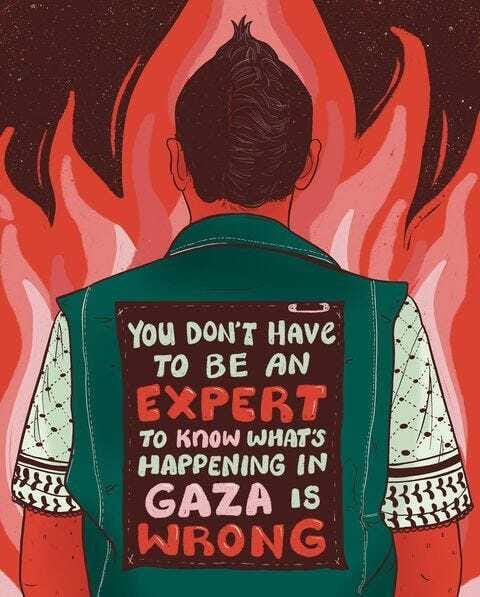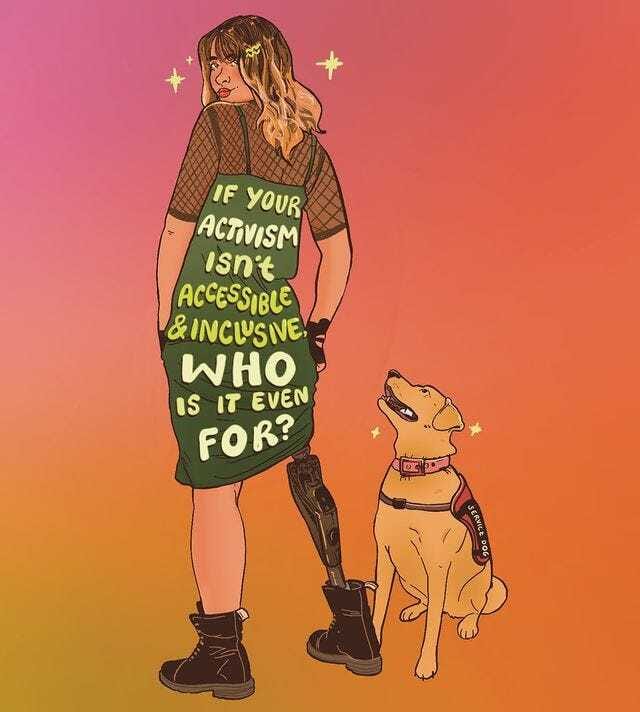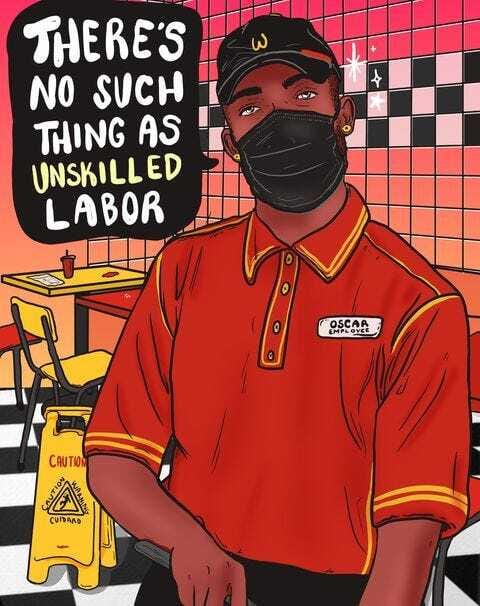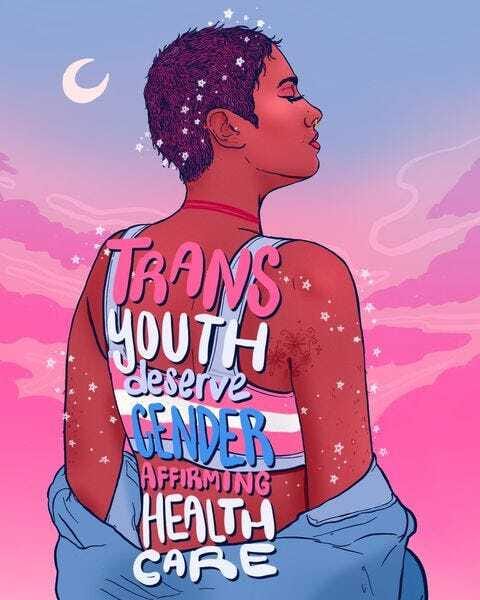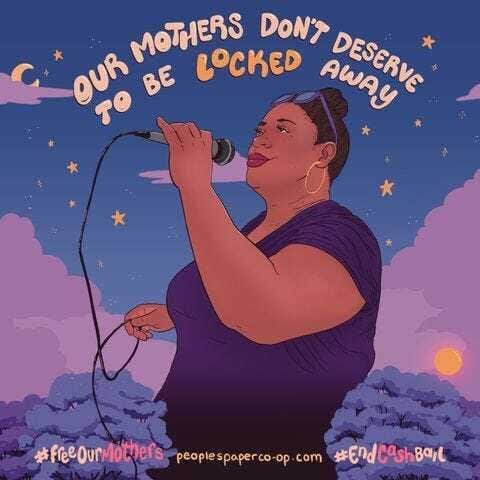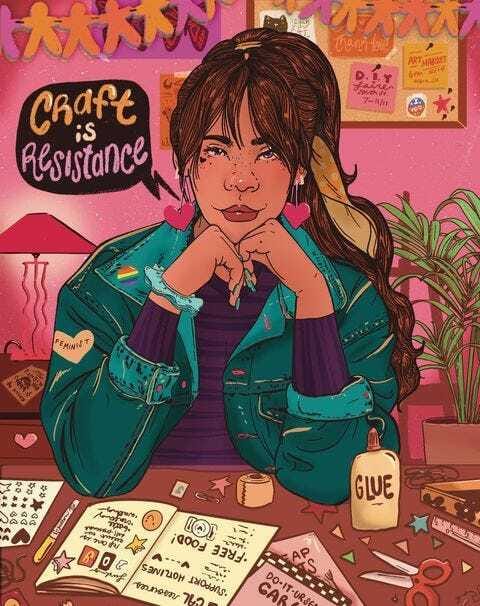- Creativity for Good
- Posts
- what can you imagine?
what can you imagine?
creativity q&a with caitlin blunnie, aka @liberaljane
Visual art is one of the oldest forms of expression — and one of the oldest forms of resistance, too. From messages scrawled on the walls of Pompeii to downtown LA’s graffiti skyscrapers, people have been using art to educate, protest, agitate, advocate, and speak truth to power for thousands of years.
If you’ve spent any time in online organizing spaces in the past few years, especially in the reproductive justice space, chances are you’ve come across art by Caitlin Blunnie — also known as Liberal Jane. Her use of bright and eye-catching colors, no-nonsense text, and accessible approach to education and advocacy has made her a staple in the world of activist art, and her art has been viewed by millions of people around the world — online and off.
They say a picture is worth a thousand words — so I won’t write you an extra-long intro! For this month’s creativity Q&A, I sat down with Caitlin — AKA @liberaljane — to talk about protest art, bodily autonomy, the nonprofit industrial complex, and the channeling imagination into tangible change.
creativity q&a with caitlin blunnie: art as activism
Tell me a bit about what creativity and creating means to you. What has your journey to becoming a full-time creative been like?
That's a great question. I'm figuring out exactly where to start because I think the journey has evolved over time. So for some context, I am from New York originally. I grew up in a very conservative, homophobic town and household space.
And I had gone to college not thinking I was going to do art, but it was like always something that just kept popping up over and over. So when I went to college, of course, I was exposed to more progressive ideas.
I would go to like the feminist group meetings and as a result of that, there was a lot of butting heads with my family. And that's actually where the username liberaljane comes from — because I'm sure you've heard names like Joe Schmoe or whatever, and that was what was sort of used to dismiss me when I was going on a rant or something.
It was like, "okay, Liberal Jane." And so when I graduated, I was like, okay, I'm gonna work in nonprofits. I'm gonna, you know, I wanna do good for the world. I was really passionate about reproductive rights. And so I was working a job in DC and I was 22, 23 after, you graduate and then you realize, oh shit, there's no jobs and then you do serving or whatever low wage job.
And you're sort of like, "oh, I was going to do really cool work for the world, but then..."
But then it's like, but actually I have to pay my rent.
Yeah, actually you're gonna be bankrupt because of a UTI because you don't have health insurance right now. Love that.
So fun!
Yeah. So I had this job in DC and, you know, I was happy to have health insurance and like a stable job, but it kind of sucked the nonprofit. And I started doing art just as a way to sort of blow off steam after work.
And I was just posting it to like my personal Instagram. It wasn't like an intentional, okay, now I'm @liberaljane. It was just sort of happening. And then you know, I think over the years that commitment has grown and changed around the same time I had an abortion.
So that, of course, pushed a lot of the advocacy work that I was doing. I saw the barriers that it took to have that abortion and how difficult it was. And so a lot of the work in the beginning was around abortion and reproductive rights.
And I think as time has gone on, I've really adopted the framework of looking at issues through the lens of bodily autonomy. And I think one of the biggest things that informed that is that back in 2020, I was outed to my family and it ended just horrifically.
Like I still, to this day, don't talk to my dad. There's been very strained family relations. And when it happened, I felt like the world was ending. Like it sent me into probably like a two year depression and mental health spiral.
And so I think over time I've realized that like this expression of bodily autonomy, it's not just about abortion, it’s not just about trans or queer rights. It's about being able to self-express and be who we are without fear, without judgment, without discrimination or violence. I'm really pushing this idea that like the best gift that you can give somebody, the best way that you can support somebody is just to allow them to be who they are. So I think that hopefully answers the question a little bit.
It really does. And I'm curious about how, you know, you started posting art on your Instagram, and it obviously has hada really big reach. So I'm curious about how you decided that, like, this is how I'm going to do this, this is how I'm making my mark, and making a difference.
Yeah, that's a great question. So as I mentioned, I was working in nonprofit and I actually worked in nonprofit until not this past October, but the October before I was working in abortion rights advocacy.
I was an organizer for many years and then I was in a role that was like not organizing director, but also more or less that. And I would go to all these high-level meetings where we would talk about messaging of, oh, we can't say this, we can say this, we can say that.
And then at the same time I was posting on my Instagram, a lot of the messaging, I would say definitely like 2021 onward, most of it I write myself. So I was looking at how the messaging, the movement wanted us to use, wasn't necessarily matching the language that everyday people were using.
Language that was resonating with real people.
Yeah, like we were so in the weeds of like, we don't want the antis to respond with this and we don't want the media to say this. And so we would be talking about the issues and these like really rounded out ways that like, just didn't, yeah, it just didn't resonate.
And then people also felt like, I don't have this language or I don't know these acronyms, so I can't participate. Or being afraid of language policing. And I think I just realized that like, I was sitting in these meetings for hours and then at the same time, I put that same amount of energy into the art and it has a thousand times more impact.
And so it was really interesting to be doing the work for so long where I was working on a local level, but then also have this national and international platform. And I think there was a disconnect between those two things, which is kind of interesting to think about.
Yeah. Yeah, I think about that all the time, like — I read statements, and I'll be like, somebody really wanted to say “fuck,” and they weren't allowed to. And one of the things that I've always loved about your work is it's like, your language is real people language. It's not academic. It's not inaccessible. It's the entry point of a normal human being who is learning, but it also totally resonates with those of us who have been in the movement and are fed up, and it's really great to be able to sort of capture all of that.
I appreciate that. I try really hard to make sure it's accessible. Because yeah, I think just, I used to be the person that would do all those trainings of like, how to talk about abortion and like, I think just growing up the way I did with my parents, where neither parent was really well-educated. I would notice the way I talked at work first, the way I talk around friends and family.
I think you straddle a really great line between education and advocacy, and also just sort of solidarity. Like there are some things that you post where it's just like, I feel like the point is that this should be seen. Like, I love your captions personally, like I always read them, but I feel like some of the times even if it's just the image, that captures the moment and the emotion and brings forth like an energy that's like, oh, yes, this is true.
Thank you so much.
One of the things that I've really loved about your work is how representative it is, that it is so diverse. Everybody can, any person could see themselves in your art, like, you know, and it, especially in the repro movement, which I think is really lagging behind a lot of different things in terms of like understanding different types of families and different types of identities and like really making sure like disability representation is there. Can you talk a bit about how that became such a core part of your work?
You know, I think in the beginning it was really interesting. Occasionally I would get people reaching out being like, I've never seen myself represented in art before and there was a lot of excitement about that.
And I think, you know, my experience working in the movement of like really believing that the people directly impacted the people who are experiencing this issue the most, those are the people that should be leading and be centered in the work.
So I think it really stems from that. And also just specifically for marginalized bodies, the more representation that we can have, the more that we can normalize it. So, you know, having somebody with a physical disability, talking about people who are neurodivergent or queer and just normalizing that, like I think it was a recent piece of mine.
The first time I had the symbol for autism, so many people were like, I've never seen that represented. And then it also opens the door for other people who may not even know what that is or have the language around it.
I think the representation helps build bridges between like, okay, this is something that impacts me for people who are directly impacted. And also for people who don't think about these issues, especially disability rights issues, like just putting a face to the issue.
I think that's such a human thing. To want to connect.
Yes. And I think, kind of jumping off that, I know at the beginning, your focus was very much on reproductive rights and reproductive justice. And now, as you go through your feed, you can sort of see it expand into workers rights, and environmental justice, and so many other issues. Do you see bodily autonomy as the lens through which you look at all of those other issues or are there other lenses that kind of come into play for you?
I would say bodily autonomy is definitely the main one, you know, working in reproductive justice for so long. I think that idea of like, really, it is all connected when we think about this in the context of being able to have free, healthy lives and families and, you know, then we can start tying in climate issues or economic issues.
I think the mistake a lot of organizations make is that because they are a single issue or they're looking only at a part of the larger picture, it doesn't quite resonate. And then it's this tough line of like, okay, we need to be intersectional, but then we also need to keep the message and the point and the goals.
And I think when you can create that fuller picture, you can get people to sort of understand what we're actually talking about. A quote that always comes to mind that I love so much is that imagination is the first step towards liberation.
Like, if we can't, if we can't picture it, if we can't articulate to people what we want and what we're actually fighting for, then like, how are we going to get that buy in? Because like, if we're just fighting for a world that's a little different than what we have now, that's not enough to disrupt the systems that are at play.
So I think being able to articulate that vision and using art to do it is so important.
Okay, thank you for that pull quote. That was perfect. Gold star.
Haha, thank you.
Something I've noticed a lot in sort of activist art is that people take very different approaches to color. Sometimes like the color is likeI see this color and I just feel like what they want me to do is like feel angry. Whereas when I see your work, I feel like what it wants me to do is feel activated in a way that is also hopeful. And so it's interesting when you talked about imagination, because it definitely makes me feel more creative to look at your art. So I'm sort of curious to know how you approach color, and how you approach the sort of impact that you want a piece to have when you're choosing those things.
Oh, that's a great question. So a couple of years ago, I started doing like, color studies, I would just look online or like, contrast color palettes and really work to understand, you know, the importance of having — usually it's a dark color that you can use for the outline, a white or creamy color, and then two contrasting colors. So like green and pink or purple and green, like that type of energy. I really like playing with those contrasts. But at this point, I'm able to sort of generate those color palettes myself instead of having to rely on what's out there already.
And I mean, color plays so much into emotion, and I've spent a lot of time working on understanding the way color plays into emotion. And I think what you said about activism art often being like red and black, like wanting to provoke that anger.
I think that that works in an immediate or emergency type response. But for the long term, like anger when we think about it isn't an emotion that can be sustained, you know, either the anger needs to move into action or commitment or it turns into apathy and just stress and overwhelm and feeling like nothing is ever going to change.
So I think color does play a role in like, getting people to look at the image and getting that attention. And when you get that buy in, it gives you the opportunity to, you know, interact with that person's thoughts and beliefs.
And It's just practice, honestly, like, I do not have an illustration degree. I avoided art for most of my life because I was like, oh, that doesn't make money. And then of course now here I am.
What a good segue. So I was gonna ask, you know, you've had so much reach and so much impact and you've also done some really cool partnerships and collaborations. Are there any particular moments or projects that really stand out to you when you think about what you've done and think, like, I'm so proud of this?
The one that comes to mind immediately is last May, I worked on the Black Mamas Bailout Project. And so that project was really cool because we got to work with mothers who are previously incarcerated, who were essentially fundraising for bail to free other mothers in time for Mother's Day.
And so getting to work side by side with somebody who's directly impacted leading in this work was an amazing experience. But also, for someone who never felt who never saw themselves depicted in art.
It was just such a meaningful experience. And it was interesting because the woman that I worked with, Tracy, ended up having very different religious beliefs than I did. She's a practicing Muslim, and I'm atheist, agnostic. I'm like a former Catholic burned by religion. But it was really beautiful to put together this image. And the image is Tracy, and she's standing with a microphone and then there's trees and there's sort of this scene of her with her children like running around in a sprinkler.
And it's just like, it's one of those moments that just really illustrates, like, the future people are looking for is so attainable by putting just this summertime scene, and putting the words together that like, mothers and kids should be together.
And just, it was so beautiful to have the poetry from these leaders to work with somebody impacted and then to have it up on billboards. I think it was Philadelphia.
Yeah, yeah, I remember seeing that when it was happening and being really moved. Just the importance of talking about incarcerated mothers — around Mother's Day, but like, also all the time.
Yeah, I mean, so many people don't know about those things. And, you know, I grew up, my dad was in and out of jail when I was growing up. And I remember him, he and my mom having to figure out how to raise the money for bail, like what accounts could we pull from?
And it is something that like, unless you've directly experienced it, you know, you might think, oh, $500 for bail, it's no big deal. But for like, a lot of people, that's what's leaving them behind bars.
And I think something that I really enjoy about your account in particular is that I think a lot of people follow you because they see your work in the repro space and then they get exposed to all of these other connections and start to have those neurons firing and be like, oh, this is connected to this and this is connected to this. And it's like, there's always an entry point and then it opens up so much more and not a lot of people are doing that. Especially because what you were talking about with nonprofits, it's that balance between, you know, we need to stay on mission, but when is our silence really noticeable?
Yeah, you know, like I love nonprofits. I have worked with many nonprofits. But I often say something that gets some people upset, which is that your job at a nonprofit should be to be working yourself out of a job.
Why are we finding new issues and problems to deal with? Like, if we set out to solve a problem, and it gets solved, great. Like, and maybe that's not a popular belief, but it's true.
Because you can always tell like, on a call, like when one person is like, I want to vibe this way. And then another person is like, sure, but we need to fundraise. So you can't do that. And I agree, like the, you know, the future is not going to happen through the nonprofit industrial complex.
It's just not. And yeah, it's very like, okay, like y’all gotta, you should be working to put yourselves out of a job.
And people are like, but I like my job!
Sure! But you know, you can like your job and also want it to not exist anymore. And that’s the world we’re really trying to create.
Caitlin Blunnie, also known as Liberal Jane, is a queer reproductive justice artivist living in Virginia. Caitlin brings over eight years of experience working in the feminist movement to her work. In Washington, D.C., Caitlin has organized and fought for reproductive rights, queer liberation and more. As an activist, she started Liberal Jane as a way to continue the fight for equality online. Over the last six years, Liberal Jane has become a trusted voice in the online feminist space. She is known for her educational content, bold messaging and wildly colorful graphics and aesthetic.
updates from shelly
Oh my gosh, y’all, it’s baby’s first Goodreads giveaway! 😍😍😍
From March 25 - April 22, enter to win one of 10 print ARCs of Rules for Ghosting. You can also add R4G to your “want to read” list — it tells my publisher that you’ve got your eye on it, and will hopefully make them more likely to buy all of my upcoming books! They will be weird and queer and Jewish, and you definitely want me to write them, so click here to enter.
resources, links, and further reading
spotlight on: art as activism
read: “how art is shaping the political landscape in the digital age”
listen: “artivism” on the Black Feminist Rants podcast (featuring caitlin)
donate: your local abortion fund! (caitlin’s pick)
Need help finding your local fund? Check out National Network Abortion Funds to find the fund nearest you.
